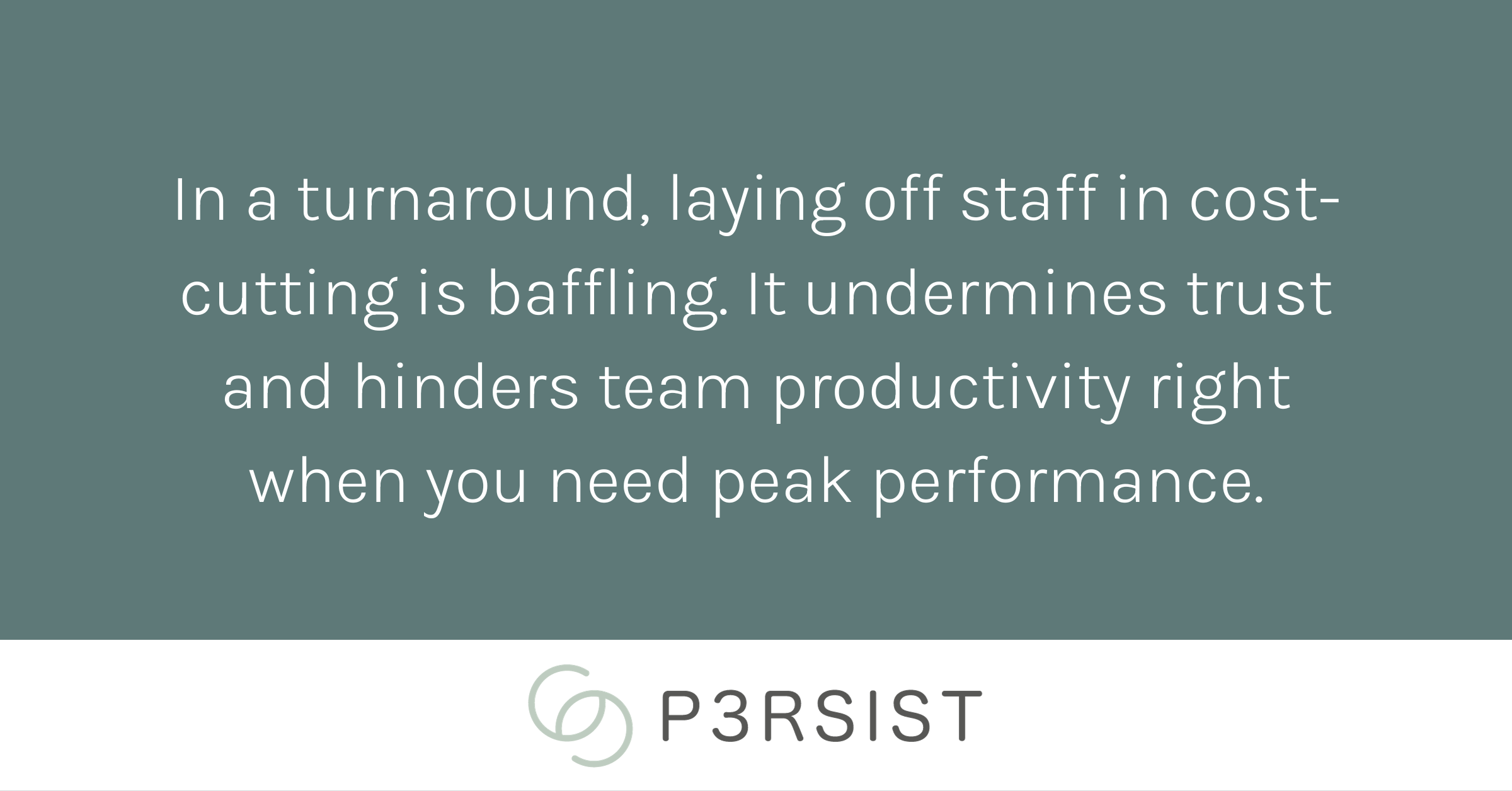- Assessment and diagnosis: understanding the root causes
- Stabilization of the business
- Developing a focused strategic plan for a business turnaround
- Conclusion: Sustaining success in turnaround operations
Performance challenges are an inevitable part of any business. Sometimes these challenges remain hidden or unaddressed for a long time and lead to financial distress. In other cases a shock occurs of such a magnitude that immediate steps need to be undertaken to address the situation. Running agri-processing businesses profitably is difficult in Africa. The landscape is littered with struggling industries and empty factories, but this does not have to be the norm. With the right approach, even businesses in dire situations can be turned around and set on a path to sustainable success.
Turnarounds call for a specific sequence of steps to be undertaken to rapidly improve a business’ prospects. We have identified four steps to achieve a successful turnaround: assessment and diagnosis, stabilization of the business, strategic planning, and operational and financial restructuring. Each of these steps plays a vital role in reviving a struggling business and setting it on a trajectory of growth.
Assessment and Diagnosis involves a thorough examination of the business to identify root causes of poor performance. This foundational step is critical to formulating effective recovery strategies.
Stabilization of the Business focuses on preventing further deterioration and creating a stable environment for rebuilding. This includes immediate financial measures to improve cash flow and reassure stakeholders.
Strategic Planning entails developing a clear roadmap from the current troubled state to a desired future state. This step requires effective communication with the team and stakeholders to ensure alignment and buy-in.
Operational and Financial Restructuring involves implementing changes on the ground to enhance operational efficiency, optimize financial performance, and secure the business’s long-term viability.
In the following sections, we will delve into each of these steps. We’ll be writing from our own experience in leading turnarounds of manufacturing operations in unforgiving environments. We’ll be using the term turnaround a lot which is mostly used in the context of businesses that have run into difficulties. However, the different steps also apply if you’re a business that is not in financial distress but experiencing a period of reduced performance.
By no means can we pretend to be comprehensive or cover all cases or industries. Nevertheless, if you are a founder, business leader, board member or investor, it is our objective to provide you with some useful insights and practical tools to help you navigate your own turnaround journey or operational performance improvement efforts.
Assessment and diagnosis: understanding the root causes
I cannot overstate the importance of proper analysis work. Too often businesses fight symptoms, not root causes. To know the fundamental causes of the challenges that the business is facing is to know the answers. That is why we’ll commit a significant portion of this article to analytical capacity.
Connecting the dots
A lot of people in our industry haven’t had very diverse experiences. So they don’t have enough dots to connect, and they end up with very linear solutions without a broad perspective on the problem. The broader one’s understanding of the human experience, the better design we will have. – Steve Jobs
This quote by Steve Jobs on design is equally applicable to business turnarounds. To assess and diagnose the root causes of the challenges that the business is facing you should not only have the analytical skills to connect dots but also a broad experience so that you have collected dots to connect in the first place. You need both analytical capacity and broad experience.
Contrary to popular belief, the most successful startup founders are age 45. See this article in the Harvard Business Review. Call it experience or wisdom, broad experience will allow for a quicker and better grasp of what the root causes for poor performance are.
If you are a founder and have been running your business for 10-20 years, there might be a good reason to attract outside expertise. Independent board members, an advisory board or outside consultants can bring in additional “dots” that can greatly enhance the collective intelligence of the leadership of the organization.
Additional “dots” can also be brought on board through regular meetings with other entrepreneurs or trusted friends with relevant experience. To prevent getting into a situation of distress, make meeting with outside experts a regular part of your thinking routines.

Financial health analysis for turnaround success
Financial skills are crucial for understanding the root causes of business challenges. It’s not magic. Balance sheets, income and cashflow statements are the starting point for the analysis. In a turnaround situation, getting an understanding of where the business stands and how it is doing, starts here.
The balance sheet will give you a good idea of the state of the business and will provide answers to some key questions:
- How leveraged is the business?
- How much does the business owe?
- Has equity been eroded over time?
- What are resources available for conversion to cash?
- How well is working capital being managed: cash, inventory, debtors, creditors, etc.
- Are there any “zombie” assets? Unverified inventory for example or debtors that are long overdue?
The income statement will provide key insights into operational performance. Most of the time there is too much focus on the income statement because it includes such vanity metrics such as turnover. Some key information from the income statement:
- Profitability
- Gross Profit
- Contribution
- Variable costs
- Overhead costs
- Interest Payments
The income statement itself is a starting point. Key insights will be gained through segmentation of the data and historical analysis: segmentation by product lines or individual products, cost center analysis, time trends, etc.
The cashflow statement is arguably the most important tool. It will give a clear picture of where the cash of the business is coming from and where it’s going. Not only is it important to analyse backward looking cashflow statements but forward looking projections as well. A rough annual cashflow forecast as well as a weekly updated monthly forecast are key to effective business management.
Other key elements of the financial analysis include the quality and frequency of bank reconciliations, inventory counts and the assets register. Bank, cash and inventory records and reconciliations are fundamental to performance monitoring and key elements of process control. If these are not done at the right intervals relevant to the business all the other financial information is of doubtful quality.
Operations assessment
When assessing a manufacturing operation in a turnaround situation here are a few of the key issues that we look at:
- Health, safety and proper housekeeping. A place for everything and everything in its place. This is an important proxy for how well operations are being run.
- The use of formal decision making systems for the management of day-to-day operations.
- Clear bills of materials, documented processes and procedures.
- Maintenance. The presence of a well tooled workshop that is neat will be a good indicator for the state of any production lines. If the workshop is next to non-existent and/or in a mess, there’s no way that the business will be able to keep its production lines going effectively.
- Process efficiency and quality. This answers the question what value the operation adds to the raw materials that went into the factory. Processing yields, defects, rework, etc. are all part of process efficiency and quality. What I want to see is factory managers and supervisors that can quantitatively tell me whether or not they are having a good day. Collection of data and feedback on performance needs to be daily, not weekly or monthly.
- Communication. Processing operations are usually quite hierarchical environments. The flow of information from top to bottom and from the bottom to the top needs to be facilitated through formal and informal systems. Visual information of key performance metrics as well as regular meetings according to pre-defined standardized agenda’s are crucial to make a manufacturing operation tick.
Together, these six elements build up a clear picture of the strengths and weaknesses of the processing operations of the business.
Market positioning and competition analysis
Marketing equals strategy. Key factors to consider are how the business is positioned in the market and an understanding of the competitive landscape. Is it competing on cost or following a differentiation strategy? Has it perhaps chosen a niche with very little competition? Does the chosen market align well with the strengths and weaknesses of the business? How do gross margins compare amongst different niche markets? Here are the key questions to consider, broken down per segment:
Target market identification:
- Is there a clear definition of the target market segment?
- Does the target market align with the strengths and weaknesses of the business?
- Are the demographics and buying behaviours of ideal clients well understood?
Competitive landscape:
- What is the level of competition?
- What is the market share held by each competitor?
- Who are the key competitors and what are their strengths and weaknesses?
Unique selling points:
- What are the business unique selling points that set it apart from the competition?
- How does the company differentiate itself in the form of product, services, quality, pricing or other factors.
Market trends and dynamics:
- Changes in client preferences over time.
- Anticipation and adaption to shifts in the market place.
- Trends, industry developments, emerging technologies.
Together with financial and operational analysis, market position is a key focus area in a turnaround situation.
Stabilization of the business
Improving performance or initiating a turnaround starts with building buy-in. It always starts with people.
Engaging your team: building buy-in
Staff in distressed businesses are understandably anxious about their future. In environments with no social safety net this is worse, also because there are few alternative employment options. Some stress helps performance, but too much results in lower engagement and productivity. The business situation asks for peak performance, so take some of that anxiety away.
Frankness goes a long way. There is no need to sugarcoat the situation. If you’ve done your homework through proper analysis (you did read the previous chapter, right?), you’ll be able to put the finger on where things go wrong and prepare a credible plan.
If you’ve correctly identified the main issues, your plan will resonate and build confidence that you can help the organization get back on track. If you are not frank or took shortcuts on your analysis, people will see through it and the result will be the opposite.
A great way to build buy-in is to have one-on-one conversations with a broad cross section of staff. What we once did was to have conversations with all permanent staff: from senior management to the drivers and the cleaners: around a hundred people. Conversations do not need to take a lot of time, 10-15 minutes per conversation is enough. Here’s a format on how to structure them:
- Introduce yourself and ask the person about their role in the organization.
- Then, ask the following questions:
- What should the organization stop doing
- What should the organization keep doing
- What should the organization start doing
- Close with asking if there is anything else that you need to know to help turn the situation around and why previous efforts to improve the situation have failed.
You’ll be surprised about the amount of relevant information you get through such conversations and usually it is the line workers who give the best insights. On top of that, everyone will have the opportunity to share their thoughts on the organization and be a part of the solution.
Then, walk the talk. As an example, when we took over management of a distressed company on behalf of a foreign shareholder, for six months we came to work in a beat-up green taxi that was barely functioning, driven by the wonderful Mr Sanou, who was always reassuring about his ability to get us to our destination in time.
Anyone who knows the green taxis of Burkina Faso knows what I’m talking about. The fact that the owners of these vehicles customize them to run on natural gas instead of petrol and that there is a gas cylinder in the trunk making a loud thud through every corner is another story.
In this situation, nothing communicated the seriousness of the situation better than our chosen mode of transport. It also showed that everyone was expected to do the things required to get the organization back to profitability.

Stabilization: Short-term measures to improve cash flow
What to do when your African agribusiness is losing money? The immediate priority is to implement short-term measures to stabilize finances and improve cash flow. The obvious measures are to cut unnecessary costs and to negotiate with creditors and suppliers.
The most important thing I want to say about cost cutting is that it baffles me that staff gets laid off first to achieve cost reductions. The first step of a turnaround is getting buy-in and providing reassurance for staff so that they can do their best work through engagement, productivity and a healthy dose of stress. Nothing undercuts this faster than laying off people. It destroys trust.
This point is even more important given the high poverty environment and social structures. The sense of community in most African countries is higher than what people from the West are used to and so the sense of betrayal through layoffs is more important. Then there is the disastrous impact of lay-offs on families: there are no unemployment benefits and alternative formal jobs are scarce. So cut unnecessary costs but clarify that all people within the organization are needed to turn the ship around.
In certain turnaround situations in factories there has been some malpractice or serious negligence involved. Obviously, you will have to take action here but the reason for that is not cost-cutting. Read our article on employee integrity challenges in African agribusiness for solutions to help prevent this situation from occurring.
Then there is the possibility to negotiate with creditors and suppliers. The same trust building exercise as with staff works here. Get their perspectives on the business, share elements of your turnaround plan to build confidence and reassure them that you intend to continue the business relationship. More often than not, I’ve found creditors and suppliers more than willing to extend credit terms, negotiate payback periods and even take substantial haircuts on outstanding amounts.
Developing a focused strategic plan for a business turnaround
Focus is essential for a successful turnaround strategy or operational improvement effort for your agribusiness. After analysis work on finances, operations and marketing as well as your talks with staff and other stakeholders you will have developed a big cloud of data points. The key issue now is connecting the dots, seeing through the noise and getting a good grip on the interconnectedness of several issues.
You cannot change everything at once and so prioritization is key. A good strategy is simple, flexible and focuses on just 3-5 key issues at a time. Start with a year plan that sets high level goals. Then start working on the priorities for the next three months. Looking further ahead is pointless as the priorities for the second quarter and beyond will depend on the outcomes of the first quarter. If you’re in a very fast-moving environment, consider making monthly plans instead of quarterly.
Because situations can be quite complex, finding interrelated issues is hugely important. You will want to find a few key challenges that if resolved, set in motion a chain of improvements further down the line. This way you can simplify the challenge and focus organizational efforts on an easy-to-understand single objective. If, in your analysis work, you did get to the actual root causes of problems, you can ignore the many symptoms that might be its result. You will also want to include one or two objectives that will enable you to create a few quick wins. This builds motivation and momentum to tackle the larger more challenging issues.
Aligning the organization with the turnaround strategy does not involve anything more than best practice for business leadership. Clear and simple messages, a meeting hierarchy with preset agenda’s, a townhall meeting to communicate with all levels of staff and if your staff is unionized, a meeting with the delegates to explain the strategy and take into account their concerns and feedback. Be transparent. We’ve written an entire article on strategy and strategy execution for African agribusiness which you can find here.
Creating your turnaround strategy:
- Prioritize
- Focus on actions that will set in motion a chain of events
- Realize a few quick wins
- Align the organization, be transparent
- Execute, execute, execute
As argued before, the critical step is correctly identifying root causes. To know the root of the problem is to know the solution. But knowledge is worth nothing without execution. You don’t want to overthink things but get to executing as quickly as you can.
Conclusion: Sustaining success in turnaround operations
Turning around a struggling agribusiness or just improving its operations is a challenging task, but with the right approach, it is entirely achievable. Going from financial distress to operational efficiency and competitiveness takes strategic analysis, decisive action, and effective execution. Our experience has shown that sustainable turnarounds are not just about quick fixes but about building robust systems that are ready for the future.
In this article, we have shared the key steps that have proven successful in our turnaround operations. From conducting thorough financial and operational assessments to developing a focused strategic plan and engaging your team, each step is required to build a stronger, more resilient business.
The essence of a successful turnaround lies in continuous improvement and adaptability. The business environment, especially in African agribusiness, is constantly evolving. Staying ahead requires not only addressing current challenges but also anticipating future ones and being prepared to adapt your strategies accordingly.
We hope this article has provided you with valuable insights and practical tools to help you run your business and improve its operations. As you implement these strategies, remember that you are not alone. P3rsist is here to support you every step of the way, offering the expertise and guidance needed to transform challenges into opportunities for growth and success.
Reach out to us to learn more about how we can assist you in achieving your business goals. Together, we can build a sustainable and prosperous future for your agribusiness.





